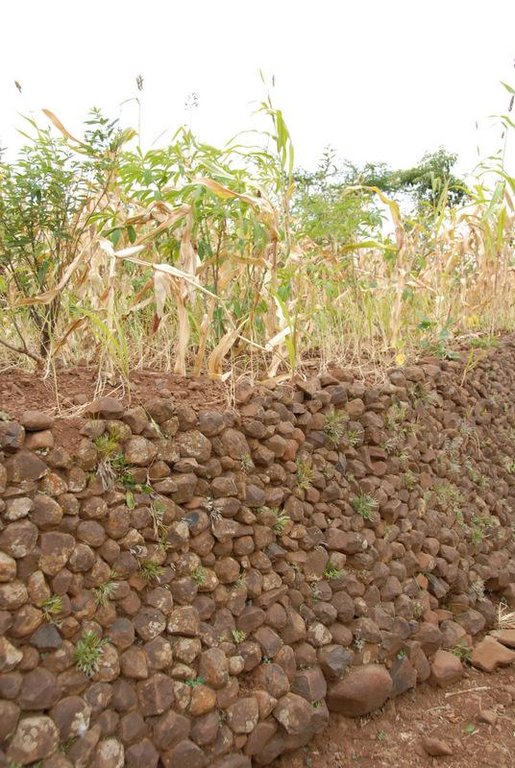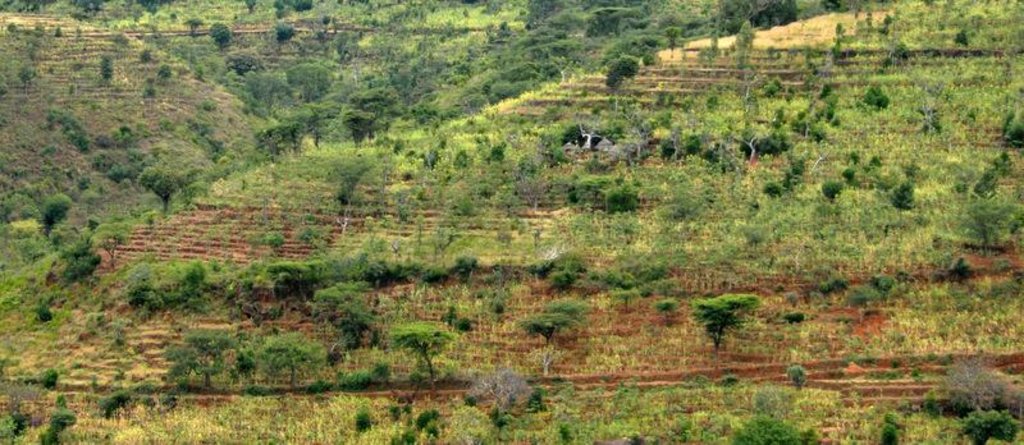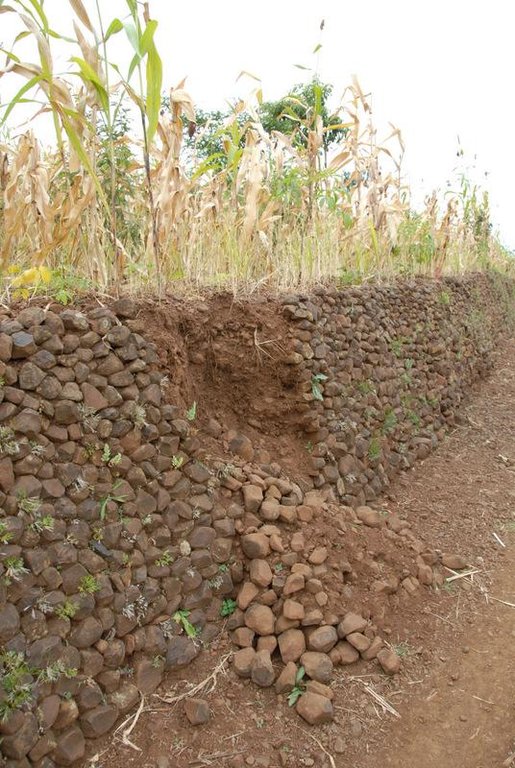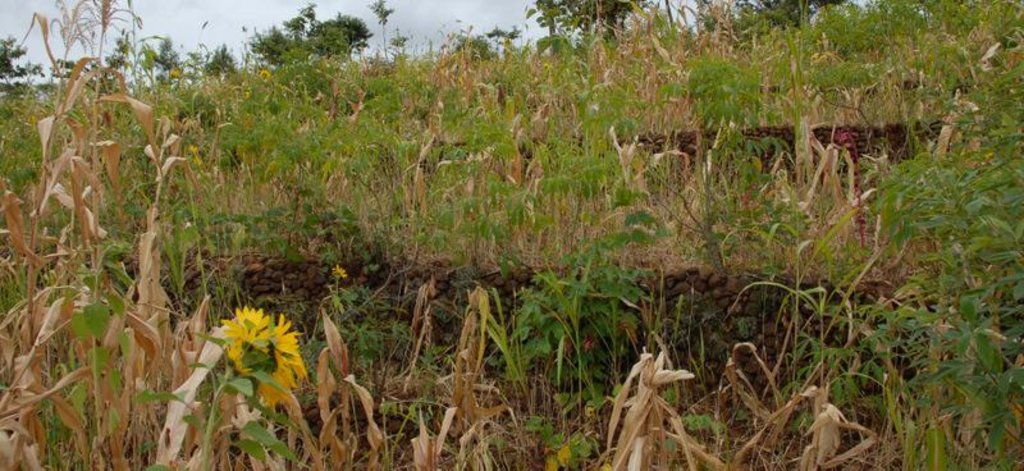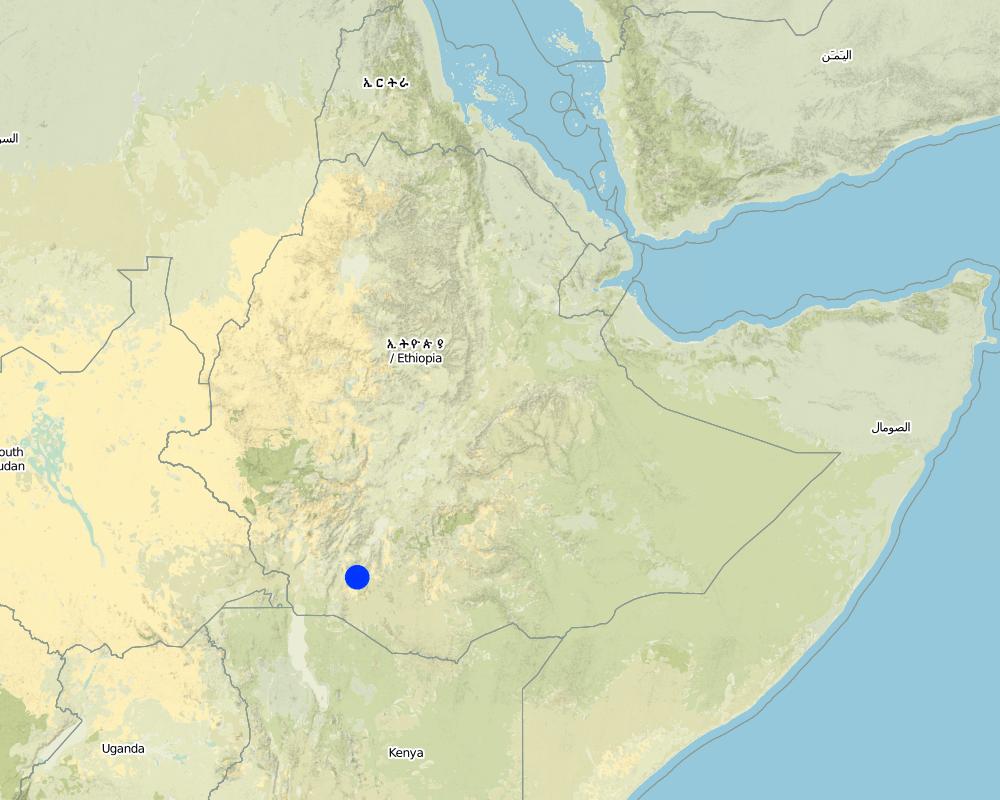Konso Bench Terrace [Ethiopia]
- Creation:
- Update:
- Compiler: Daniel Danano
- Editor: –
- Reviewer: Alexandra Gavilano
Kawata (Konso)
technologies_949 - Ethiopia
View sections
Expand all Collapse all1. General information
1.3 Conditions regarding the use of data documented through WOCAT
When were the data compiled (in the field)?
10/10/2002
The compiler and key resource person(s) accept the conditions regarding the use of data documented through WOCAT:
Yes
2. Description of the SLM Technology
2.1 Short description of the Technology
Definition of the Technology:
It is a stone wall embankment along the contour with land leveling in between two terrace walls to control erosion.
2.2 Detailed description of the Technology
Description:
The traditional Konso Bench Terraces are established by building up stone embarkments along the contour and gradually levelling the land in between risers. Levelling is done actively and by siltation processes. Stone walls have to be enhanced periodically. The appearance of the technology evolves over time from stone empankments to bench terraces. The stone walls are supported on the downslope side by trees and / or legumes including coffee, pigeon pea, etc.
Purpose of the Technology: The purpose of the structures is to break the slope length and reduce run-off concentration thereby controlling erosion, increasing water stored in soil and harvesting eroded sediments.
Establishment / maintenance activities and inputs: Terraces have a long tradition in the area, and farmers are specialists in construction of stone walls. The first step during terrace establishment is to dig foundation up to 30 cm. Then stone walls are gradually built up to an impressive height of 1.5-2m above ground. The technology is very labour intensive: establishment takes 5 years and bi-annual maintenance is required. However, it is worth the effort, since without terracing crop production would not be thinkable in a marginal area characterised by shortage and high variability of rainfall, shallow, stony soils on steep slopes, high levels of soil erosion and (thus) frequent food shortages.
Natural / human environment: Social systems for labour-sharing and voluntary assistance have evolved to manage heavy labour inputs. Multiple cropping is practised for rist aversion. Growing leguminous crops helps to further improve soil fertility. Additional water harvesting measures are needed to further raise yields.
2.3 Photos of the Technology
2.5 Country/ region/ locations where the Technology has been applied and which are covered by this assessment
Country:
Ethiopia
Region/ State/ Province:
Konso
Further specification of location:
SNNPR
Map
×2.6 Date of implementation
If precise year is not known, indicate approximate date:
- more than 50 years ago (traditional)
2.7 Introduction of the Technology
Specify how the Technology was introduced:
- as part of a traditional system (> 50 years)
Comments (type of project, etc.):
Traditionally practiced since long time (Inhereted from ancestors)
3. Classification of the SLM Technology
3.2 Current land use type(s) where the Technology is applied

Cropland
- Annual cropping
Comments:
Major land use problems (compiler’s opinion): Land shortage, moisture stress, soil fertility decline, shallow soil depth, high cost of farm inputs and pest attack.
Major land use problems (land users’ perception): Low rainfall, land shortage, pest and high price of fertilizers
Type of cropping system and major crops comments: Sorghum/maize, oil crops, peas
3.3 Further information about land use
Water supply for the land on which the Technology is applied:
- rainfed
Number of growing seasons per year:
- 2
Specify:
Longest growing period in days: 70
Longest growing period from month to month: Mar - May
Second longest growing period in days: 50
Second longest growing period from month to month: Aug - Oct
3.5 Spread of the Technology
Specify the spread of the Technology:
- evenly spread over an area
If the Technology is evenly spread over an area, indicate approximate area covered:
- 1,000-10,000 km2
Comments:
Konso Bench practice started over 400 years ago (Elders interview) and it is practiced through out sloping lands in Konso Woreda.
3.6 SLM measures comprising the Technology

structural measures
- S1: Terraces

vegetative measures
- V1: Tree and shrub cover
Comments:
Main measures: structural measures
Secondary measures: vegetative measures
Type of agronomic measures: better crop cover, early planting
3.7 Main types of land degradation addressed by the Technology

soil erosion by water
- Wt: loss of topsoil/ surface erosion

water degradation
- Ha: aridification

chemical soil deterioration
- Cn: fertility decline and reduced organic matter content (not caused by erosion)
Comments:
Main type of degradation addressed: Wt: loss of topsoil / surface erosion
Secondary types of degradation addressed: Cn: fertility decline and reduced organic matter content, Ha: aridification
Main causes of degradation: other human induced causes (specify) (Agricultural causes), other natural causes (avalanches, volcanic eruptions, mud flows, highly susceptible natural resources, extreme topography, etc.) specify, poverty / wealth (Lack of captial)
Secondary causes of degradation: labour availability (Lack of labour)
3.8 Prevention, reduction, or restoration of land degradation
Specify the goal of the Technology with regard to land degradation:
- reduce land degradation
- restore/ rehabilitate severely degraded land
Comments:
Main goals: mitigation / reduction of land degradation
Secondary goals: rehabilitation / reclamation of denuded land
4. Technical specifications, implementation activities, inputs, and costs
4.2 Technical specifications/ explanations of technical drawing
Technical knowledge required for field staff / advisors: moderate
Technical knowledge required for land users: moderate
Main technical functions: increase / maintain water stored in soil
Secondary technical functions: reduction of slope angle, sediment retention / trapping, sediment harvesting
Construction material (earth): The earth used for supporting the wall on the up slope part
Construction material (stone): The stone is used to form wall of the bench
If the original slope has changed as a result of the Technology, the slope today is: 0%
Lateral gradient along the structure: 0%
Vegetation is used for stabilisation of structures.
4.3 General information regarding the calculation of inputs and costs
other/ national currency (specify):
Ethiopian Birr
Indicate exchange rate from USD to local currency (if relevant): 1 USD =:
8.50
Indicate average wage cost of hired labour per day:
0.60
4.4 Establishment activities
| Activity | Type of measure | Timing | |
|---|---|---|---|
| 1. | Survey (traditional) | Structural | dry season |
| 2. | Stone collection | Structural | dry season |
| 3. | Digging foundation | Structural | dry season |
| 4. | Soil sealing & land leveling | Structural | dry season |
| 5. | Constructions of stone wall | Structural | dry season |
4.5 Costs and inputs needed for establishment
Comments:
Duration of establishment phase: 60 month(s)
4.6 Maintenance/ recurrent activities
| Activity | Type of measure | Timing/ frequency | |
|---|---|---|---|
| 1. | Stabilizing by putting additional stones | Structural | after rain/once a year |
| 2. | The stone wallsupported by soil | Structural | after rain/once a year |
| 3. | Planting on the bench | Structural | during the rain/once a year |
| 4. | Land preparation | Agronomic | dry season / 2-3 |
| 5. | Land preparation | Agronomic | dry season / 2-3 |
| 6. | Land preparation | Agronomic | dry season / 2-3 |
4.7 Costs and inputs needed for maintenance/ recurrent activities (per year)
Comments:
On the basis of kilometers treated per hectar
Remarks: Duration of establishment phase is 5 years. Land users maintain the terrace at least twice a year, mainly while preparing the land for crops. Labour inputs for maintainance are usually 25-30% of construction. Daily wage of hired labour is about US$ 1; material costs include collection and sizing of stones.
4.8 Most important factors affecting the costs
Describe the most determinate factors affecting the costs:
Labour, farm implements, soil workability, surface stoniness
5. Natural and human environment
5.1 Climate
Annual rainfall
- < 250 mm
- 251-500 mm
- 501-750 mm
- 751-1,000 mm
- 1,001-1,500 mm
- 1,501-2,000 mm
- 2,001-3,000 mm
- 3,001-4,000 mm
- > 4,000 mm
Agro-climatic zone
- semi-arid
Thermal climate class: tropics
5.2 Topography
Slopes on average:
- flat (0-2%)
- gentle (3-5%)
- moderate (6-10%)
- rolling (11-15%)
- hilly (16-30%)
- steep (31-60%)
- very steep (>60%)
Landforms:
- plateau/plains
- ridges
- mountain slopes
- hill slopes
- footslopes
- valley floors
Altitudinal zone:
- 0-100 m a.s.l.
- 101-500 m a.s.l.
- 501-1,000 m a.s.l.
- 1,001-1,500 m a.s.l.
- 1,501-2,000 m a.s.l.
- 2,001-2,500 m a.s.l.
- 2,501-3,000 m a.s.l.
- 3,001-4,000 m a.s.l.
- > 4,000 m a.s.l.
5.3 Soils
Soil depth on average:
- very shallow (0-20 cm)
- shallow (21-50 cm)
- moderately deep (51-80 cm)
- deep (81-120 cm)
- very deep (> 120 cm)
Soil texture (topsoil):
- medium (loamy, silty)
- coarse/ light (sandy)
Topsoil organic matter:
- medium (1-3%)
- low (<1%)
5.6 Characteristics of land users applying the Technology
Market orientation of production system:
- subsistence (self-supply)
Off-farm income:
- less than 10% of all income
Relative level of wealth:
- average
- poor
Individuals or groups:
- individual/ household
Level of mechanization:
- manual work
Indicate other relevant characteristics of the land users:
Land users applying the Technology are mainly common / average land users
Population density: 50-100 persons/km2
Annual population growth: 2% - 3%
60% of the land users are average wealthy and own 60% of the land.
25% of the land users are poor and own 35% of the land.
15% of the land users are poor and own 5% of the land.
Off-farm income specification: No considerable difference
5.7 Average area of land owned or leased by land users applying the Technology
- < 0.5 ha
- 0.5-1 ha
- 1-2 ha
- 2-5 ha
- 5-15 ha
- 15-50 ha
- 50-100 ha
- 100-500 ha
- 500-1,000 ha
- 1,000-10,000 ha
- > 10,000 ha
Is this considered small-, medium- or large-scale (referring to local context)?
- small-scale
5.8 Land ownership, land use rights, and water use rights
Land ownership:
- state
Land use rights:
- individual
6. Impacts and concluding statements
6.1 On-site impacts the Technology has shown
Socio-economic impacts
Production
crop production
Quantity before SLM:
0.4
Quantity after SLM:
0.6
Income and costs
farm income
Socio-cultural impacts
community institutions
Ecological impacts
Water cycle/ runoff
surface runoff
Soil
soil moisture
soil loss
soil organic matter/ below ground C
6.2 Off-site impacts the Technology has shown
downstream flooding
downstream siltation
6.3 Exposure and sensitivity of the Technology to gradual climate change and climate-related extremes/ disasters (as perceived by land users)
Gradual climate change
Gradual climate change
| Season | Type of climatic change/ extreme | How does the Technology cope with it? | |
|---|---|---|---|
| annual temperature | increase | well |
Climate-related extremes (disasters)
Meteorological disasters
| How does the Technology cope with it? | |
|---|---|
| local rainstorm | well |
| local windstorm | well |
Climatological disasters
| How does the Technology cope with it? | |
|---|---|
| drought | well |
Comments:
Tolerant to climatic extremes (e.g. rain storms). Water conservation effect increases resilience to periods of water stress.
6.4 Cost-benefit analysis
How do the benefits compare with the establishment costs (from land users’ perspective)?
Short-term returns:
negative
Long-term returns:
slightly positive
How do the benefits compare with the maintenance/ recurrent costs (from land users' perspective)?
Short-term returns:
slightly positive
Long-term returns:
positive
Comments:
La marge bénéficiaire est très faible, mais sans terrasses, pas de cultures possibles. Les exploitants continueront à investir dans des terrasses tant qu’ils pourront en tirer un moyen d’existence
6.5 Adoption of the Technology
Comments:
10% of land user families have adopted the Technology with external material support
Comments on acceptance with external material support: survey results
90% of land user families have adopted the Technology without any external material support
Comments on spontaneous adoption: estimates
There is a strong trend towards spontaneous adoption of the Technology
Comments on adoption trend: The technology is over 400 years old and it is already adopted
6.8 Weaknesses/ disadvantages/ risks of the Technology and ways of overcoming them
| Weaknesses/ disadvantages/ risks in the land user’s view | How can they be overcome? |
|---|---|
| Les terrasse nécessitent un entretien très fréquent, ce qui rend cette technologie très exigeante en main-d’œuvre | utiliser de plus grosses pierres lors de la construction ; éviter le pâturage libre (les animaux endommagent les structures) |
| Weaknesses/ disadvantages/ risks in the compiler’s or other key resource person’s view | How can they be overcome? |
|---|---|
| The terraces require very frequent maintenance which makes the technology highly labour-demanding. | Use bigger stones for construction; avoid free grazing (animals damage the structures). |
7. References and links
7.2 References to available publications
Title, author, year, ISBN:
Danano, D. 2008 (unpublished). Soil and Water Conservation Practices for Sustainable Land Management in Ethiopia. Ethiocat.
Links and modules
Expand all Collapse allLinks
No links
Modules
No modules



